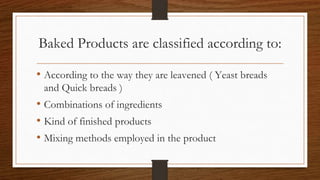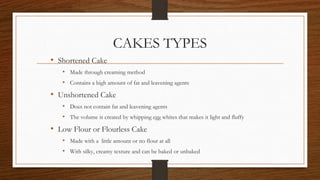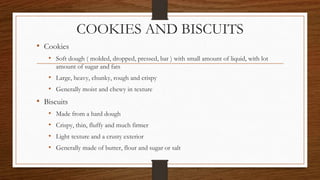Technology and Livelihood Education Classifications of breads.pptx
- 1. Classifications of Breads February 15, 2023 / Third Quarter
- 2. LIFE PERFORMANCE OUTCOME • LPO4: Conscientious, Adept PERFORMERS & ACHIEVERS • I am a conscientious, adept performer and achiever, competently pursuing my mission in life.
- 3. ESSENTIAL PERFORMANCE OUTCOME • EPO9: Remain focused on fully completing projects, proposals and/or outputs of pre-established quality in a timely manner. (LPO4)
- 4. INTENDED LEARNING OUTCOME Remain focused on fully completing baking projects, and outputs of pre- established quality in a timely manner. (EPO 9, LPO4)
- 5. VIDEOS • Classifications of Bread • https://youtu.be/swoKre8fWhM
- 6. Processing Questions: •How are baked products classified? •What are the general categories of baked products?
- 7. Baked Products are classified according to: • According to the way they are leavened ( Yeast breads and Quick breads ) • Combinations of ingredients • Kind of finished products • Mixing methods employed in the product
- 8. Categories of Baked Products • Pies and pastries • Cakes • Cookies and Biscuits • Yeast breads • Quick breads
- 9. PIES AND PASTRIES • Pies are made with pastry dough crust and with added fillings like fruits, custard and cream • Pastries are made of flour, liquid and high amount of fat that contributes to the flaky texture.
- 10. CAKES TYPES • Shortened Cake • Made through creaming method • Contains a high amount of fat and leavening agents • Unshortened Cake • Does not contain fat and leavening agents • The volume is created by whipping egg whites that makes it light and fluffy • Low Flour or Flourless Cake • Made with a little amount or no flour at all • With silky, creamy texture and can be baked or unbaked
- 11. COOKIES AND BISCUITS • Cookies • Soft dough ( molded, dropped, pressed, bar ) with small amount of liquid, with lot amount of sugar and fats • Large, heavy, chunky, rough and crispy • Generally moist and chewy in texture • Biscuits • Made from a hard dough • Crispy, thin, fluffy and much firmer • Light texture and a crusty exterior • Generally made of butter, flour and sugar or salt
- 12. YEAST BREADS • Uses yeast as a leavening agent • It is combining warm water and sugar with yeast causes the yeast to multiply and release carbon dioxide, which, when mixed with dry ingredients, creates a soft loaf of bread. • Kneading is done to develop a gluten in the dough
- 13. MUFFINS and CUPCAKES • Muffins • Denser texture similar to bread • Made from thicker butter • Cupcakes • Made by creaming the butter • Lighter and fluffier texture • Made from soft and smooth batter • Can be topped with icing or frosting
- 14. Group Activity • Present a visual presentation summarizing the concept of the assigned classification of bread in your group. Include names and pictures of particular examples of baked product.
- 15. ASSIGNED COMPONENT 1. Pies and Pastries 2. Quick breads 3. Cakes 4. Cookies 5. Yeast breads
- 16. SELF – DIRECTED LEARNING ACTIVITY • Make a digital scrapbook of bread and pastry production. Indicate the tools, materials, equipment, ingredients, importance, career opportunities, classifications and all significant insights you have gained from the lesson. Then, choose one LPO to integrate in the activity. • Due: March 10, 2022
















